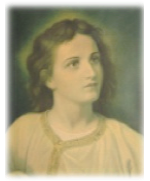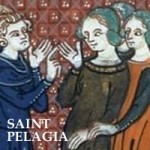Beloved in Christ, today we celebrate the Passion of John the Baptist, when he was beheaded. In ancient liturgical art, we see interestingly, that the head of John the Baptist is depicted as if on the paten at Mass. In those days, instead of the small flat plate we use for the Host, the paten was more of a dish or a platter. So there are these paintings of John’s head on this paten at Mass, why?
.
As we know, the Old Testament is full of symbols or types, which point to the coming Savior. John the Baptist becomes the greatest ‘type’ or image of Christ.
.
Of the figures of the Old Testament who symbolized Jesus, they all seemed to have died a natural death. None of them paid the ultimate price. In the Old Law, the idea of sacrificing oneself for the other was not known.
.
But in the New Law, Jesus will say, ‘There is no greater love than to lay down one’s life for one’s friends.’ John the Baptist did this. John pointed out the Savior: ‘Behold, the Lamb of God.’ And no sooner did he do this, than Herod arrested him. We read today what happened then: Herod’s daughter did a dance to entertain Herod’s guests; King Herod promised her anything, and she asks for John’s head – on a platter! And so it is done. He gave his life for the Truth, he becomes the greatest and final Type, pointing to Jesus. So let us see the interesting meaning of this gruesome head on a dish.
.
John is an image of Christ, for sure. If this is the case, then his body is an image of the Body of Christ. St. Paul says, that we are all members of his Body, and Christ is the Head. So that Head on the dish, represents Jesus, the Head of the Mystical Body, on a platter – or at least on a paten.
.
As I mentioned, in liturgical art, we see that this head of John is depicted as if on the paten at Mass, which once was more like a dish.[i] One ancient writer says: “The head of John on a dish signifies the body of Christ by which we are fed at the holy altar.”[ii]
.
So when the priest offers up the paten, with the Sacred Host on it, we see our Head there, the Head of the Mystical Body. In a remarkable symbol then, John’s Head on the dish, is an image of the Holy Eucharist,[iii] and this is seen in the Prayer after Communion for today’s Mass.
.
John was an excellent witness for the Lord. We are to be witnesses as well, even if it means giving our life.
[i] “The severed head of Saint John the Baptist, executed at the request of Salome, King Herod’s stepdaughter, rests on a charger. In later interpretations of the story….. the charger, passed around the table with John’s head, becomes a precedent for the ceremony of the Eucharist.” – http://www.getty.edu/art/gettyguide/artObjectDetails?artobj=1511
.
[ii] [i] Breviarum ad usum insignis Eccelsie Eboracensis, ed. S.W. Lawley, 2 vols. (Durham: Andrews & Co., 1880-3), “In festo decollationis sancti johannis baptiste,” Lectio v, 2.817. This and other meanings of the Baptist’s head are surveyed in Janes, Losing Our Heads, 97-138. Note: The Use of York, Eboracum in Latin, was a variant of the Roman Rite practised in part of northern England, prior to the reign of Henry VIII. During Henry’s reign the Use of York was suppressed in favour of the Sarum rite, followed by the Book of Common Prayer.
.
[iii] Today’s Prayer after Communion for this day says: ‘Grant, O Lord, as we celebrate the heavenly birth of St. John the Baptist, that we may revere, for what it signifies, the saving Sacrament we have received…’


